A Barlow lens is an optical accessory that is commonly used in telescopes for both visual and photographic observations. Its primary function is to increase the range of magnification and enhance the overall image quality.
Exploring the Purpose of the Barlow Lens
So, what is the purpose of incorporating a Barlow lens into your telescope setup? Unlike other components of an astronomical telescope, the Barlow lens allows you to achieve a higher focal length. This is made possible through the utilization of a built-in negative diffusing lens. By reducing the angle of the converging rays from the aperture, the negative double-convex glass effectively extends the focal length of the telescope.
The effectiveness of a Barlow lens can be measured by its magnification ratio, which determines the level of magnification achieved.
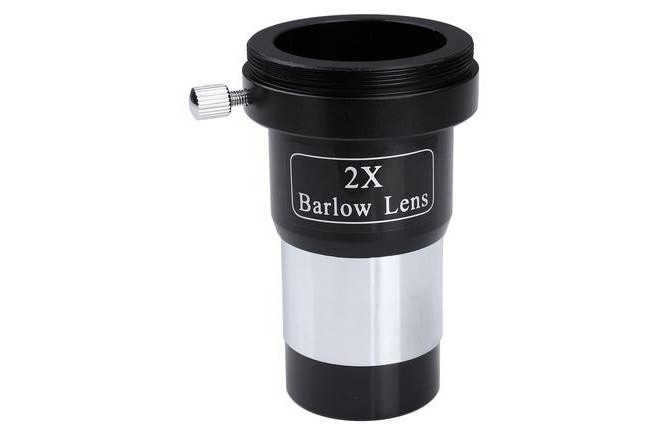
Typically, telescopes are equipped with models of various magnification levels, ranging from 2x to 5x. The magnification level represents the degree of increase in the focal length of the aperture. Some models even have less common multiples, such as 2.5x or 2.25x. The medium magnification level of 3x is commonly found in observation telescopes. Higher magnifications, such as 3x or more, allow for capturing high-quality photographs. However, the 2x Barlow lens remains the most popular choice among consumers.
The structure of the set
The lens contains a housing that houses the optical component. The package of the factory includes the following items:
– a metal housing, typically black in color, with a brand label and model designation;
– a metal clamping screw that secures the eyepiece, with a seating diameter of 1.25”;
– a T-shaped thread on the upper part of the housing, which allows for attaching the lens to a camera or other photographic equipment;
– an adapter ring with a 1.25” thread, allowing for the attachment of the entire optical unit and light filters with a similar thread size;
– a groove designed to prevent the part from falling out if not properly secured in the telescope focuser;
– a negative achromatic lens, bonded as part of the optical unit, designed for dispersion, with a total diameter of 2.4 cm. The clear diameter is 2.2 cm and the thickness is 0.7 cm.
When the lens is in use, it is positioned with the flat side facing outwards and the convex side inside the telescope. The edges of the lens are blackened at the ends. The surface of the lens has multiple layers of blue-violet luminescence. To attach the lens to the optical block, a sealing ring is used, which is screwed onto the thread.
This particular part, which is made in China, is commonly labeled as a Barlow T-Adapter 1×1.4” with a specific model number. When fully assembled, it has a total height of 7.3 cm.
Take into account the 2x magnification model. The Barlow lens, which is composed of two elements that are glued together, has an eyepiece fitting size of 1.25mm and provides a magnification factor of 2. It features a T-thread and also has an illumination capability. It weighs approximately 90 g. The Barlow lens circuit incorporates a built-in light filter.
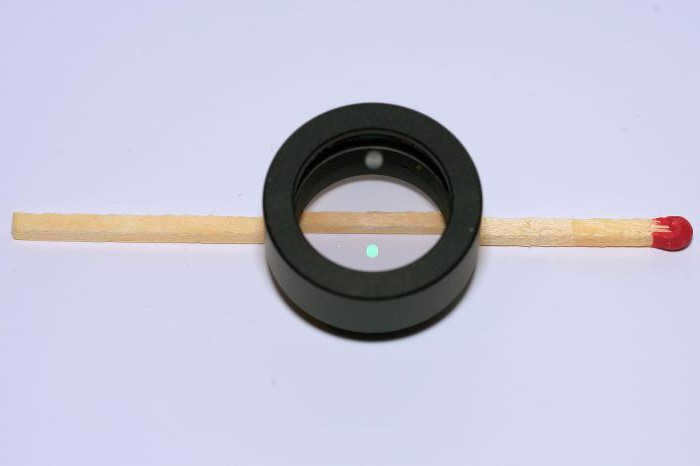
The unique feature of this device is its ability to remove the entire optical unit along with the magnifier and replace it with any filter of the desired size.
The results are quite impressive: with the installation of polarizing light filters, the brightness of the Moon can be reduced, and sunspots become more defined (especially when using specialized Baader Solar Continuum filters). Color filters enhance the contrast of details on minor planets.
The basic functions are performed at a satisfactory level. When the lens and optical unit are removed, only the sleeve with the light filter remains, which can also serve as an adapter.
Operating Principle
This device is a versatile tool that enables both astronomical observation and photography. It is designed to be compatible with SLR cameras, allowing you to capture stunning images of the night sky. The device features a T-thread, which serves as an adapter, allowing you to attach any camera model using a T-ring. This makes it incredibly convenient and easy to use with different camera setups.
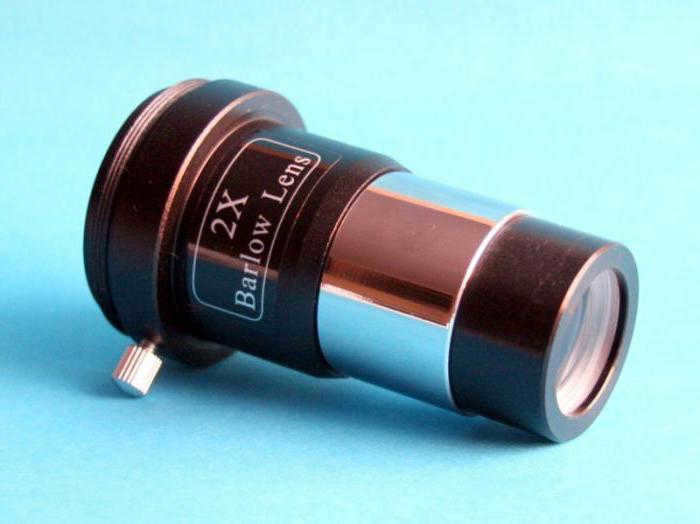
Astronomical photography can be achieved in various focal lengths, even without using a Barlow lens. The optical block with the lens can be removed at any time, allowing the user to adapt the telescope’s focus to any light filter for direct focus photography.
This provides a cost-effective solution for capturing high-quality, contrasting images in astronomy. The device enables a wider pupil exit and helps to minimize aberrations that may occur during magnification.
Device equipped with an adapter
The Celestron 2x Barlow lens with a T adapter is essentially the same as the regular model, with the only difference being the presence of an adapter, which adds a slight difference in weight. Both types of lenses produce identical images, with no structural differences in the magnification capabilities. The construction, mechanics, and optics of the lens ensure a high-quality image with sharpness, clarity, and a maximum magnification of up to 160x.
By using the magnifier with the adapter, it becomes possible to observe Jupiter and its prominent belts, consisting of four major bands, as well as the famous Great Red Spot.
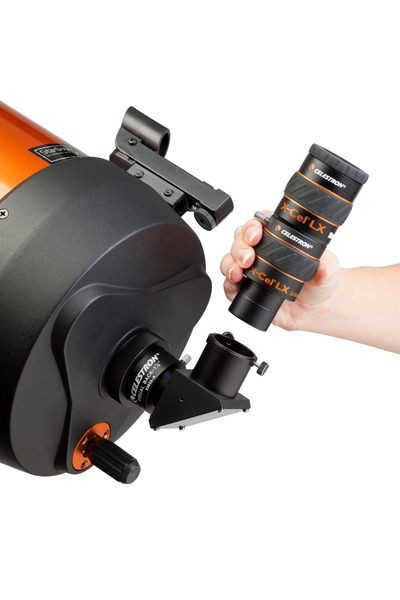
The image of the rings of Saturn, along with its cloud belts, is truly impressive. Pairing it with a different eyepiece, such as the SkyWatcher, allows for the observation of the lunar and solar surfaces, complete with craters and other fascinating formations.
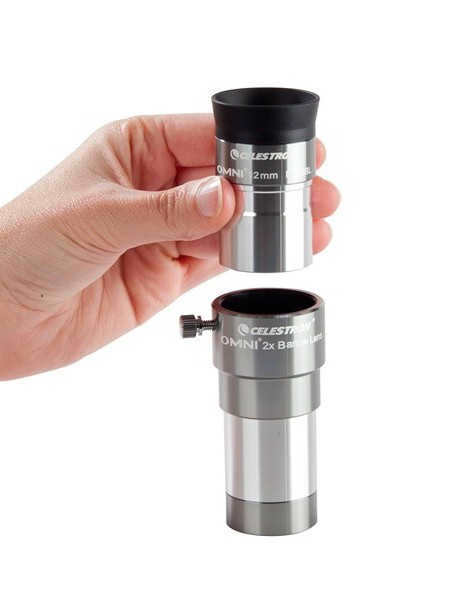
Various individual flashes, spots, and flares can be observed on the surface of the Sun. The high-quality imagery is achieved through the collaborative efforts of two lenses – their combined function helps reduce aberration and eliminate any additional chromatic aberration. However, Barlow’s devices tend to perform less effectively when used in conjunction with wide-angle eyepieces. It is much more convenient to pair them with short-range eyepieces and simpler designs, such as Ramsden, Kelner, Plossl, and others.
Users’ Feedback
What is the feedback on the Barlow lens? The majority of customers are praising the product for its positive attributes.
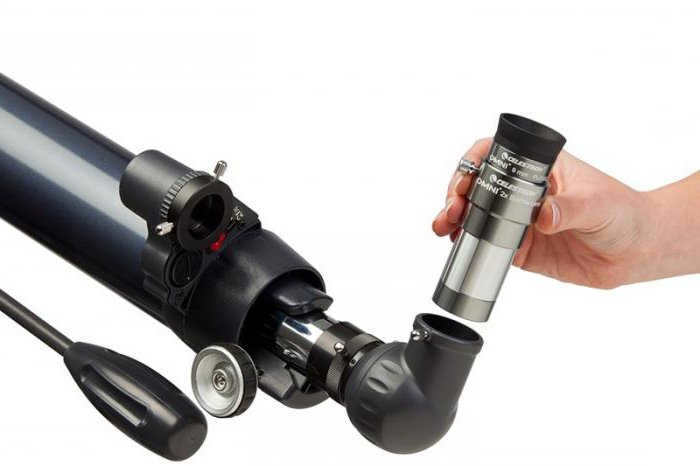
These magnifiers are ideal for beginners as they offer all the necessary features for photography and astronomical observations at an affordable price. The model with an adapter allows for a more in-depth and detailed observation of celestial objects with maximum clarity. The choice of the lens depends on the individual needs and budget of the researcher or photographer.
The purpose of this article is not to promote advertising, but rather to provide a genuine review based on my personal experience. As a beginner in astronomy, it can be challenging to find affordable tools, so I wanted to share some helpful information that may benefit others in the same situation. Unfortunately, there is very limited information available on astrotools from Aliexpress online, and most store reviews are uninformative, simply stating that the product arrived and looks good without any testing.
Therefore, I kindly request that you share your own experiences of purchasing various useful items for beginner astronomers. Whether your experience was positive or negative, all insights will be valuable.
Barlow lens purchased from Aliexpress
You can find the link to the store where the Barlow 2X lens was purchased at the end of this article, but let’s now take a closer look at the lens itself. While it may not be anything extraordinary, it is clear upon first inspection that this lens is well-made, unlike many of the commonly available consumer goods that often deceive novice amateur astronomers. Let’s examine the notable differences:
- The housing is entirely made of metal, unlike cheaper Barlow lenses that may be made of plastic.
- It features a T-thread for attaching a non-lens camera instead of an eyepiece. In contrast, lower-quality Barlow lenses may lack this thread.
- The lens block is removable and can be easily unscrewed. In the following section, we’ll explore the advantages this removable lens block provides. In inferior models, the lens block is not removable, and the lens itself may be secured with a regular locking ring.
- The lens clearly displays a green glow, which is a distinguishing feature. In contrast, low-quality lenses often lack any noticeable glow.
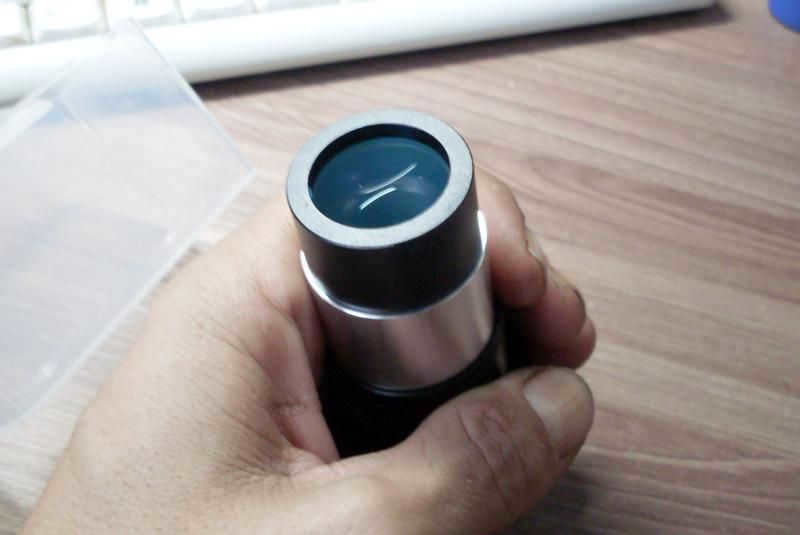
The green beam of light is easily observable.
Now, let’s detach the lens unit and examine the lens’s quality on its own. It is secured by an internally threaded ring. As you can observe, the lens is composed of a pair of glass lenses that have been glued together, with the glue being blackened at the edges as it should be. In subpar Barlow lenses, the lens is either made of plastic or glass, but it is singular and significantly degrades the image in the telescope.
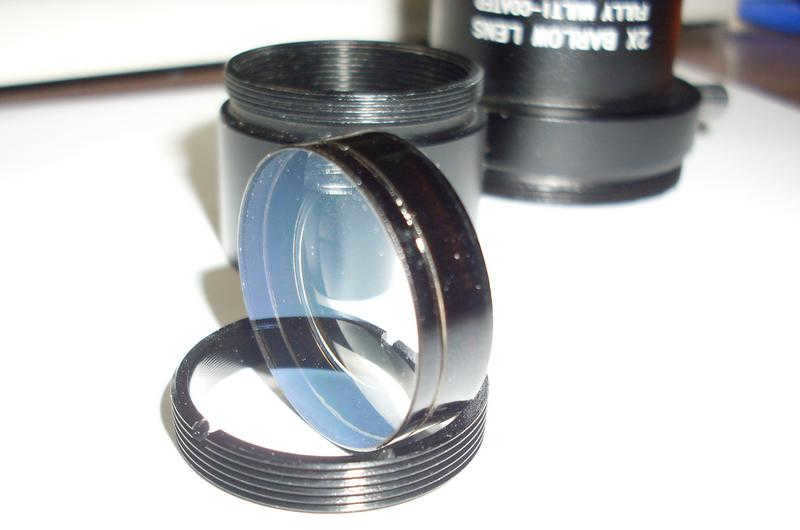
The lens is composed of two glass lenses that have been bonded together.
It is evident that the quality is well maintained. We have a high-quality achromatic lens made of glass, with a lumen that can be easily detached from the casing. As a result, we can expect a comfortable viewing experience for various objects with this Barlow lens.
Experimenting with the Barlow lens purchased from Aliexpress
Regrettably, I am unable to provide any visuals captured using the Barlow lens as I lack a suitable camera and autoguide. Nevertheless, I possess a Sky Watcher 909EQ2 telescope equipped with two complete 10mm and 25mm eyepieces. This particular telescope has previously been discussed on this platform and is widely regarded as exceptional. I conducted a series of tests using the Barlow lens and will now share my impressions.
My initial target was the Orion Nebula. Despite the scorching temperature of 30 degrees Celsius, my eagerness to commence the experiments was undeniable. Surprisingly, I managed to obtain a fairly sharp image even when utilizing the 10mm eyepiece, which is generally not renowned for its quality. Nonetheless, it alone provides a magnification of 90x on this telescope, and when combined with the 2X Barlow lens, it enables the realization of the telescope’s maximum useful magnification of 180x.
So, I was able to capture a relatively clear picture in the Orion Nebula using this Barlow lens at its maximum magnification. I was able to see some details that were not visible with just the eyepiece. I could clearly observe the fibrous nature of the nebula, and the Trapezium stars were scattered throughout the field of view. Overall, I was satisfied with the results, although I was quite cold while observing.
Next, I decided to test the Barlow lens on Jupiter. To my surprise, the planet looked much more interesting at a magnification of 180x compared to 90x. I expected the Barlow lens to distort the image or introduce chromatic aberration, but that was not the case. The image quality was quite good, and I could clearly see the belts on Jupiter’s disk with some additional details. The only downside was that it took a bit longer to focus. Unfortunately, I didn’t have the opportunity to observe Mars, which was nearby, as it was getting late and the morning light was starting to appear.
Without a doubt, I tested out this Barlow lens on the Moon too. I must say – the image was remarkably clear without any grievances. Naturally, there is some slight blurriness at the periphery of the field of view, but this is to be expected with any Barlow lens, and it does not impede the overall experience.
All in all, this lens offers superb quality at a very reasonable price.
Variations in Utilizing the Barlow Lens
I will not be revealing groundbreaking information for seasoned astronomers, but beginners may find this knowledge invaluable. In this article, I will explain the optimal methods for utilizing the Barlow lens.
Like any other lens, the Barlow lens can be used conventionally by placing it in front of the eyepiece, as depicted in the photo. This configuration will provide the standard magnification of 2X.
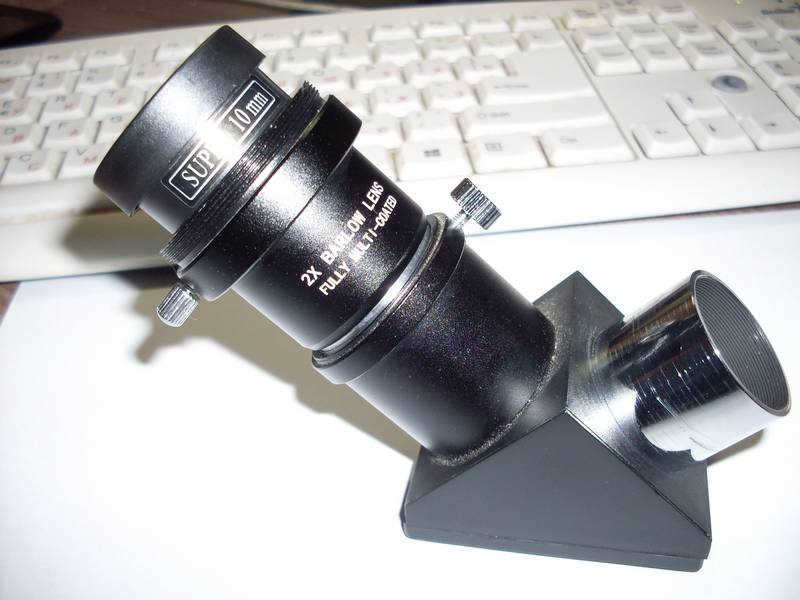
The typical placement of the Barlow lens is in front of the eyepiece. The level of magnification is equivalent to what is specified on the device.
However, the removable lens block offers significant benefits. For instance, it can be securely attached to the eyepiece, resulting in a Barlow lens magnification of 1.5X instead of 2X.
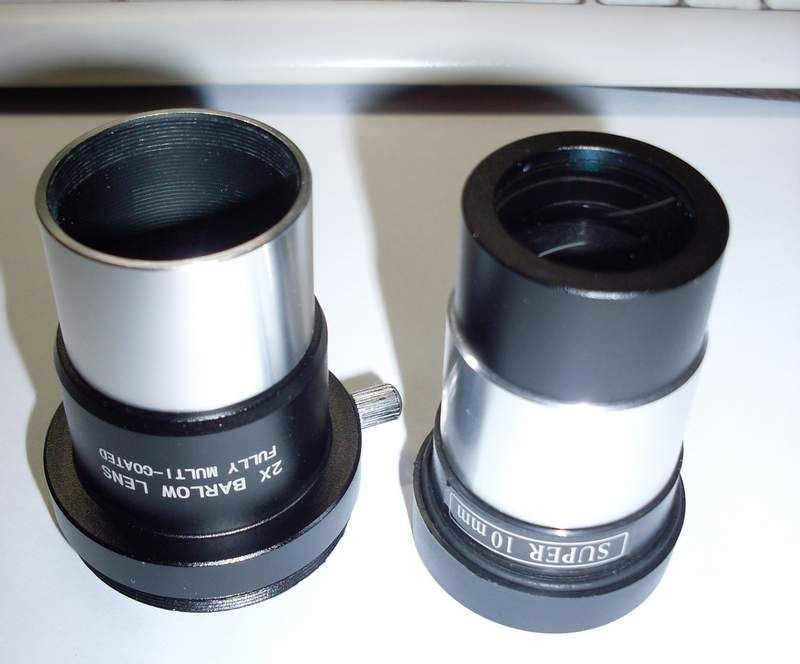
The Barlow lens is attached to a standard 10-mm eyepiece by screwing it into place (on the right). The lens housing is located on the left. This combination results in a magnification of 1.5X in the eyepiece.
Alternatively, the Barlow lens can be screwed into a diagonal mirror, which increases the magnification to 3X. This elongates the distance between the lens and the eyepiece, a phenomenon known as acceleration.
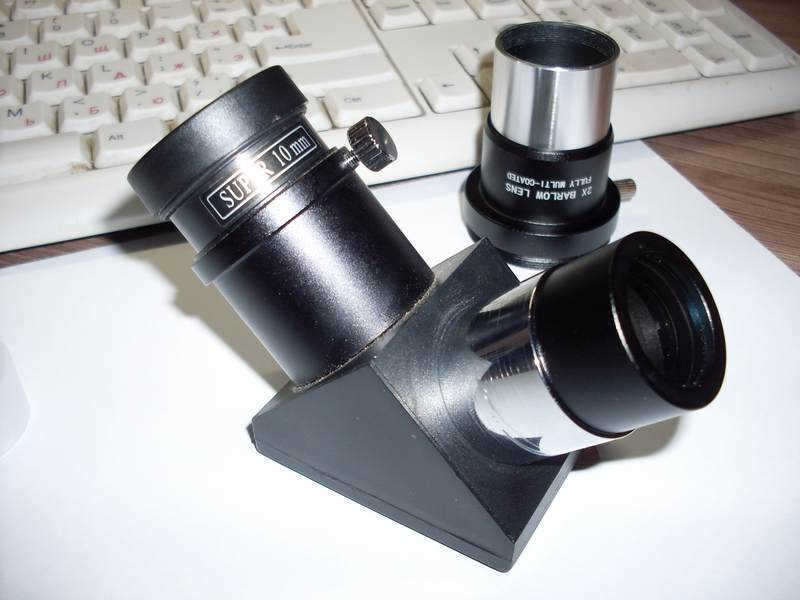
The Barlow lens is attached to the front of the diagonal mirror, providing a 3X magnification.
Alternatively, the Barlow lens assembly can be positioned in front of the diagonal mirror to achieve a 4X magnification.
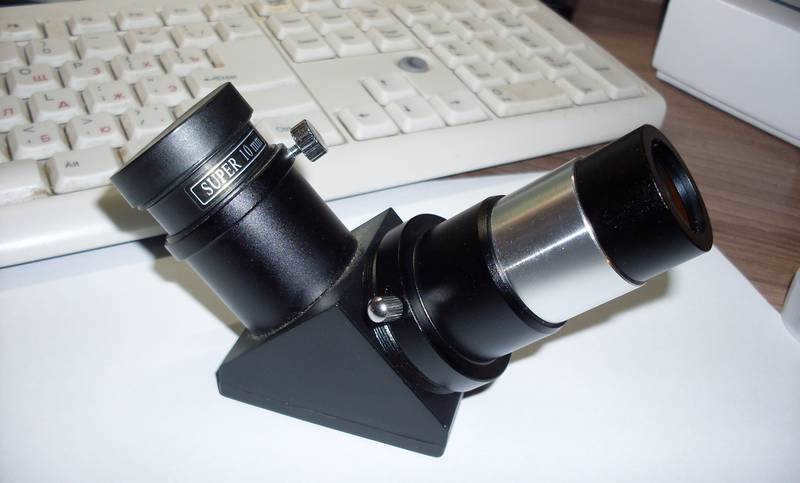

The Barlow lens is placed in the housing in front of the diagonal mirror, resulting in a 4X magnification.
By using this Barlow lens 2X, we can easily achieve different levels of magnification – 1.5X, 2X, 3X, and 4X, without the need for additional extension tubes or any other accessories. What are the benefits of this?
For instance, when using my 10mm eyepiece alone, the telescope magnification is 90x. By adding or removing the Barlow lens, I can achieve a range of telescope magnifications – 90x, 135x, 180x, 270x, and 360x (although the last two would be too high). Similarly, with the 25mm kit eyepiece, I can achieve magnifications of 36x, 54x, 72x, 108x, and 144x.
Where can I purchase?
There is a wide selection of Barlow lenses available on Aliexpress. However, it is important to be cautious as many of them are of poor quality and have a single plastic lens. Therefore, it is crucial to make a wise choice by not only reading reviews but also seeking recommendations from other websites where people have already purchased similar products.
Here, I provide a link to the exact Barlow lens that I personally purchased and reviewed in this article. This particular lens is reliable, but I cannot vouch for the others as I have not had the opportunity to examine them myself.
And here’s another helpful tip – make your purchases on Aliexpress using a cashback service. I personally use Epn.bz, an official partner of Aliexpress, that offers the highest cashback percentage. The best part is that you can withdraw your saved money in any amount and instantly, unlike other similar services. Plus, they also have a wide range of discount coupons available. By saving money, you can buy other useful things, as astronomy is not a cheap hobby and any savings will definitely come in handy. That’s all for now, good luck and may you have clear skies!
The Barlow lens is an essential component of the “arsenal” for almost every amateur astronomer who uses a telescope to observe the night sky. While it may not always be included with the telescope, it is often provided. This simple device allows you to increase the magnification by several times and expand the range of magnifications without needing to purchase additional eyepieces.
By the way, this invention can be attributed to Peter Barlow, an English mathematician and physicist who lived during the 18th and 19th centuries. He is renowned for his numerous contributions to the fields of cryptography, number theory, and more.
The concept behind the Barlow lens
Essentially, the Barlow lens functions as a negative lens that disperses light instead of converging it at the focal point. While it may appear as a single negative lens, it is actually an achromatic lens that minimizes distortion through the process of gluing multiple lenses together.
When positioned in front of a lens’ focus, the Barlow lens effectively increases the focal length due to its optical properties.
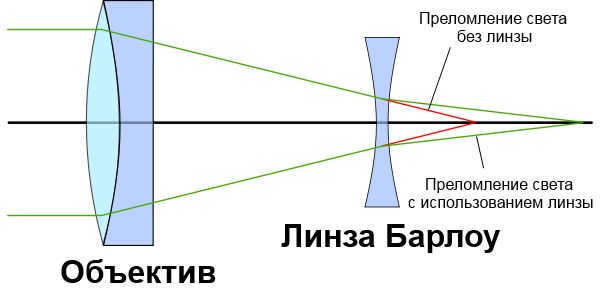
The operational principle of the Barlow lens.
The currently available Barlow lenses are designated with multiples of 2x, 3x, and 5x. The magnification denotes the number of times the focal length of the lens is augmented by this particular Barlow lens. What is its function?
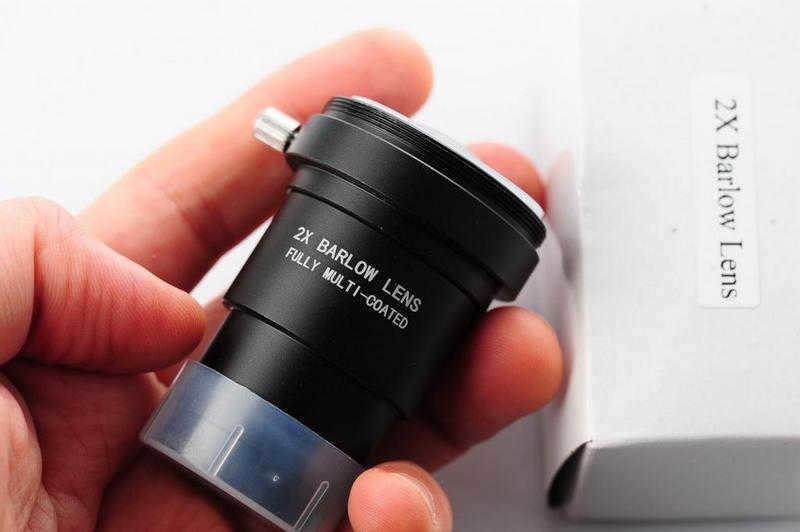
As you are aware, the calculation for telescope magnification is quite straightforward – it involves dividing the focal length of the lens by the focal length of the eyepiece. For instance, if we have a lens with a focal length of 900 mm and an eyepiece with a focal length of 10 mm, the magnification would be 900/10 = 90x. If we were to use a 25mm eyepiece, the magnification would be 900/25 = 36x. This is exemplified by the Synta Sky-Watcher 909 telescope, which includes a lens and a pair of eyepieces with these specifications. The same calculation applies to any telescope.
- The magnification for the 10mm eyepiece was calculated as 900/10 = 90x, and it increased to 1800/10 = 180x;
- The magnification for the 25-mm eyepiece was calculated as 900/25 = 36x, and it increased to 1800/25 = 90x.
Therefore, by using just two eyepieces, we can achieve the following magnifications – 36x, 90x, 180x. The 10mm eyepiece without a Barlow lens and the 25mm eyepiece with a Barlow lens both result in a magnification of 90x, so there are only three possible variations, although a different combination of eyepieces could potentially yield four. Consequently, each eyepiece in the set provides two magnification options, with and without the Barlow lens.
Therefore, by using a 3x Barlow lens, you can effectively increase the focal length of the objective by threefold. Similarly, a 5x lens will increase the focal length by five times. This increase in focal length also corresponds to an increase in magnification. However, it is important to exercise caution when using higher magnifications. For instance, if you have a lens with a diameter of 90mm, the maximum usable magnification would be 180x (90 multiplied by 2). It is worth noting that at higher magnifications, the quality of the image typically deteriorates.
The Function of the Barlow Lens
As indicated by the aforementioned theory, the Barlow lens provides a convenient way to increase magnification using the same eyepieces. However, the same outcome can be achieved by utilizing shorter eyepieces. For instance, in our particular scenario, a 5mm eyepiece can yield a magnification of 180x. So, what is the practical purpose of a Barlow lens?
- There exist telescopes with very short focal lengths that necessitate short-focus eyepieces for higher magnification. These eyepieces are not only challenging to come by, but they are also significantly more expensive than regular telescopes. The Barlow lens enables individuals to utilize common types of eyepieces instead.
- The Barlow lens is particularly handy for observing objects that emit a lot of light, like the Moon and planets, because it enhances the magnification of the resulting image. It is especially crucial for photography as well, as it allows for capturing intricate details up close, which can be further enhanced during post-processing to yield even better results.

The Barlow lens includes a T-adapter thread, which is a type of adapter for the lens thread. In some cases, the lens comes with the adapter already attached. It is screwed into the lens sleeve, and the camera can be connected to it.
Advantages and disadvantages of using a Barlow lens
We have already mentioned the ability to achieve a wider range of magnifications and its usefulness in photography, but there is more to it.
Many eyepieces do not perform well on telescopes with high levels of light power, especially those with large objective lens diameters and short focal lengths. By using a Barlow lens, a more favorable environment is created for these eyepieces, reducing the aberrations and distortions introduced by the eyepiece and resulting in a clearer image.
There are also some drawbacks associated with the Barlow lens, which are quite significant. The ongoing debate revolves around whether or not it is necessary to utilize this particular device. One major disadvantage is that the Barlow lens introduces its own set of distortions, including astigmatism and distortion around the peripheral view. Ultra-wide-angle eyepieces can potentially cause vignetting, resulting in darkening at the edges and even obstructing the field of view. Opting for an appropriate short-focus eyepiece is always a preferable choice over utilizing an eyepiece + Barlow lens combination.
If a Barlow lens with a low magnification of 1.5 – 2x is employed, the distortions are reduced. However, as the magnification increases, the quality of the image deteriorates, particularly at the edges.
One of the main reasons why people tend to avoid using a Barlow lens is because of the generally low quality that is often associated with it. Inexpensive telescopes usually come with Barlow lenses that are of very poor quality. These lenses often lack any kind of coating, and in some cases, they are even made of plastic. As a result, using such a Barlow lens does not produce the desired effect – the image is distorted, and you can only see something clearly when observing the moon. However, it is important to note that a high-quality Barlow lens is a different story altogether, and it can be extremely useful. Typically, these lenses need to be purchased separately, but they are much more affordable than eyepieces.
Dispersion of the Barlow Lens
The multiplicity of the Barlow lens, as stated on its case, is effective under normal design conditions – when the lens is inserted into the focuser and the eyepiece is inserted into it. However, by increasing the distance between the lens and the eyepiece, the magnification can be further increased. To achieve this, inserts of varying lengths can be used between the Barlow lens and the eyepiece. Therefore, by increasing the distance by 1.5 times for the 2x lens, we can achieve an “overclocked” 3x Barlow lens.
In addition, the use of a diagonal mirror between the Barlow lens and the eyepiece can also result in increased magnification.
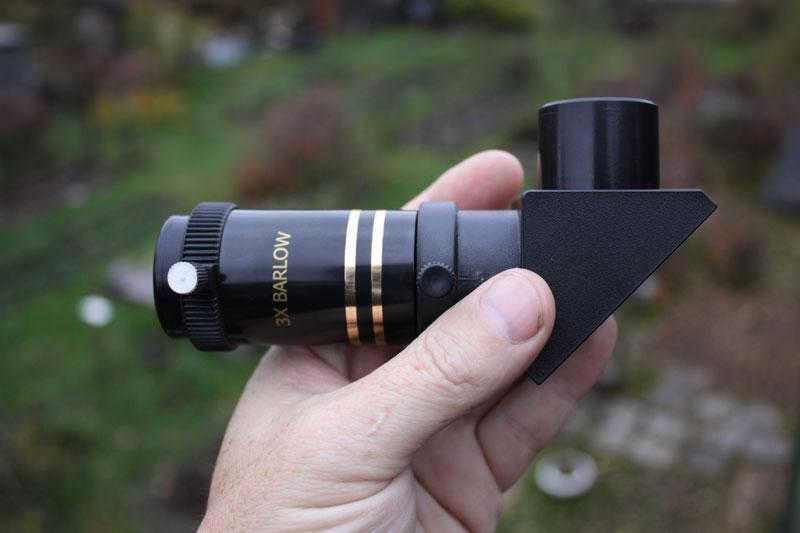
The placement of the diagonal mirror between the Barlow lens and the eyepiece is essential.
Do I need to purchase a Barlow lens?
Undoubtedly, if you are considering how to achieve the desired level of magnification – by purchasing the appropriate eyepiece or a Barlow lens, the choice should be clear – go for the eyepiece. This will enable you to achieve the desired level of magnification while maintaining the highest possible image quality.
For larger telescopes, this accessory may not be particularly relevant, but it can be quite useful for those on a budget.
Earlier, we discussed the situations in which a Barlow lens can still be useful. Let’s summarize:
- When it is not feasible to purchase expensive eyepieces for each level of magnification (and inexpensive ones are typically of subpar quality), the Barlow lens offers the ability to double the capabilities of every available eyepiece. By utilizing dispersal sleeves of various lengths, a wide range of magnifications can be achieved.
- In situations where the appropriate short-focus eyepiece may not be accessible – such as with a short-focus telescope featuring a respectable aperture.
- When the need arises to attach a camera, a Barlow lens proves highly advantageous. It enables the desired magnification of the image to be obtained. Furthermore, it is even possible to detach the lens itself and solely utilize the sleeve with the T-adapter.
Furthermore, it has already been stated that the utilization of a Barlow lens can occasionally have a positive impact on the eyepiece, mitigating its distortion. As a result, the image is not only preserved, but even enhanced. By the way, the photograph of the Moon featured as a screensaver at the beginning of the article was captured utilizing a 2x Barlow lens – the quality, as evident, is quite satisfactory.
This Barlow lens is an incredibly practical accessory that can effortlessly and effectively expand the capabilities of a compact telescope. However, caution should be exercised when purchasing, lest one inadvertently acquire a Chinese imitation with subpar plastic optics. Typically, a 2x Barlow lens is sufficient – the most prevalent option. I would advise exploring the Barlow lens options available on aliexpress, which boast commendable quality and affordability.
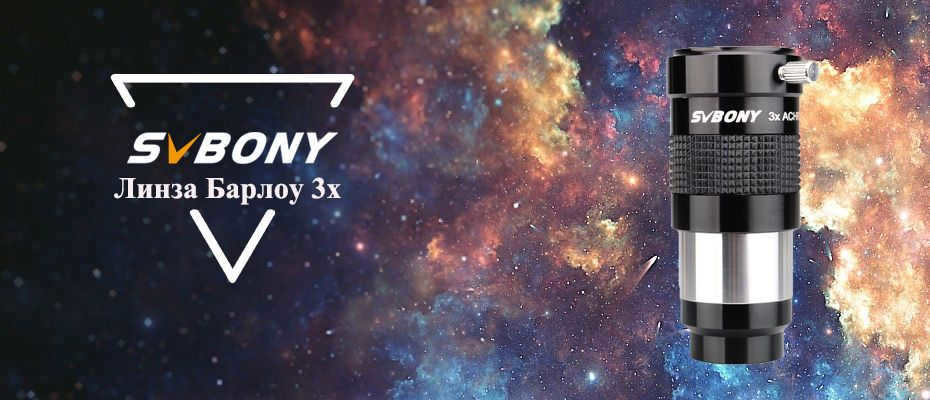
Why is a Barlow lens necessary? + SVBONY Barlow x3 Review
For those engaged in astronomy, it is often necessary to acquire various accessories to enhance the experience of observing or astrophotography. The market offers a wide array of products to choose from, making it challenging for beginners to make a decision. To address this issue, I have written an article about the Barlow lens, along with a review of the threefold Barlow lens manufactured by SvBony.
Thank you for taking the time to read this article. I hope that it will assist beginners in gaining a better understanding of astrophotography and observing!
Why should I use a Barlow lens?
In order to have a comfortable observing experience, it is recommended to use a range of magnifications, from low to high. Here are 7 key points to consider:
1. Equinox D/6 – ideal for searching for eyepieces and observing large nebulae;
2. Moderate D/3 – suitable for objects in the Messier catalog;
3. Medium D/2 – great for observing bright galaxies and nebulae;
4. Penetrating 0.7*D – perfect for observing small galaxies, planetary nebulae, and clusters;
5. Large 1*D – ideal for observing the Moon, Sun, and planets’ satellites;
6. Resolution 1.4*D – allows you to see details on the surface of the Moon, planets, and the Sun;
7. Limiting 2*D – perfect for observing double stars, the Moon, and Mars.
D refers to the aperture of the telescope in mm
As it is evident, to acquire all the convenient magnifications, one must purchase a substantial amount of eyepieces. However, is it worth expending a significant sum of money on them? Certainly not. The solution to this predicament is to invest in a Barlow lens.
The focal length of the telescope is increased by a factor of n when using the Barlow lens. For instance, if we have a telescope with an aperture of 150mm and a focal length of 750mm (F), and an eyepiece with a focal length of 20mm (f), we can achieve a magnification of 37x (750/20) (calculated using the formula: Focal length of telescope/focal length of eyepiece). With the Barlow lens X3, the focal length becomes 750*3=2250. Consequently, the magnification provided by the eyepiece with a focal length of 20mm will be: 2250/20=112-fold. It is worth noting that by using one Barlow lens and a pair of eyepieces with different focal lengths, you can achieve almost all necessary magnifications for comfortable observation.
In the field of astrophotography, the Barlow lens is utilized to further magnify the angular size of objects. The higher the quality of the lens, the better the resulting image will be in the photograph.
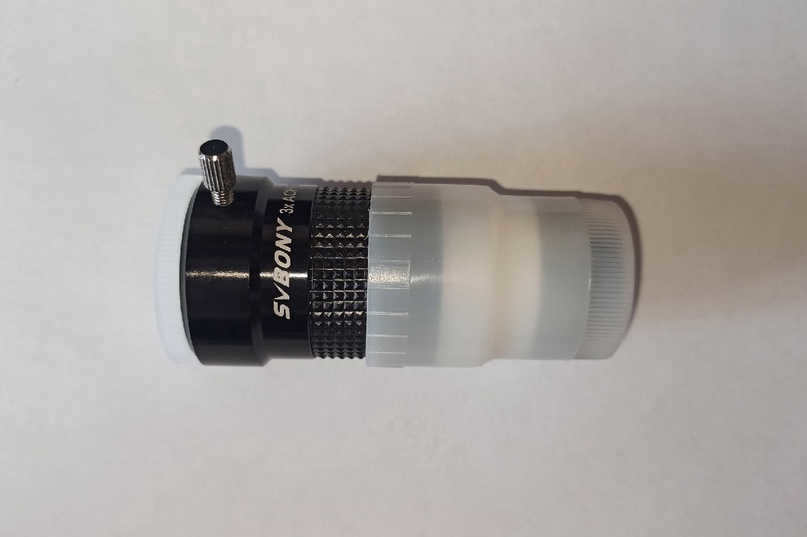
The main material used in the construction of this accessory is metal. The lens is achromatic, designed to fit a standard 1.25” eyepiece seat and can be easily unscrewed. Additionally, there are two practical covers provided to safeguard the lens from dust and other particles.

Regrettably, the lens was delivered to me with a minor flaw. The nature of this flaw is unknown to me, although it will not affect the quality of the pictures. My colleagues, who also use this lens, have not experienced any defects.
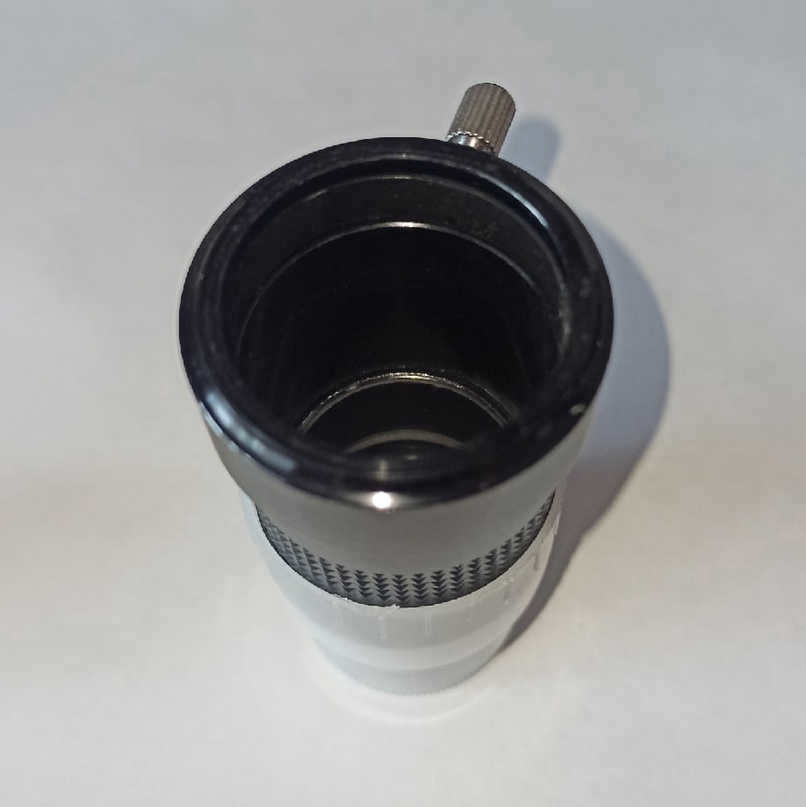
This landing is specifically designed to fit under the eyepiece or camera.
Instead of using two screws, the eyepiece/camera is securely held in place using a compression ring, ensuring a perfect mounting location.
I am overall satisfied with the lens’s quality. Currently, it stands as one of the top Barlow lenses in its price range.
Astrophoto Testing
For my experiment, I chose to compare the images captured by my telescope during moon and dip shooting.
My equipment includes the SkyWatcher 2001EQ5 telescope, a QHY-462C camera, and a UV/IR Cut filter.
First, I conducted a moon test focusing on the Copernicus crater. Below is a collage of three images:
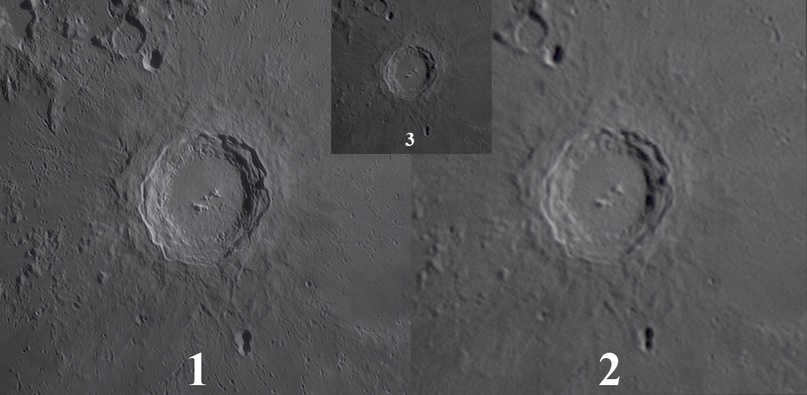
A brief overview of processing and capturing:
Stacking 200 frames out of 10000;
Sharpening in Astra Image 3.0 using deconvolution;
Shutter speed with Barlow lens: 15 ms, Gain/ISO – 0;
Shutter speed without lens: 1 ms, Gain/ISO – 0.
Let’s take a closer look at what is depicted in the photos individually:
1- Unstretched, cropped image captured by a telescope with a Barlow lens.
2- Stretched to the same size as image 1, cropped photo captured by a telescope without a lens.
3- Unstretched, cropped image captured by a telescope without any lenses.
Formally, we are interested in images 1 and 2. Image 3 simply demonstrates how much smaller the object in direct focus appears compared to the object with the Barlow lens. In photo 1, we can observe relatively small craters, ridges, mountains, etc. In photo 2, such objects appear sparser or are absent altogether.
The utilization of the Barlow lens allowed us to greatly enhance the resolution of the image compared to not using it. However, what is the maximum potential for such magnifications?
In my personal viewpoint, there are two crucial factors that determine this limit:
1) The atmospheric conditions (seeing)
2) The brightness of the image.
1- The atmosphere presents itself as the greatest obstacle for amateurs attempting to discern the most intricate details. Even with a sizable telescope, if the atmospheric conditions are unfavorable, the resulting photos will appear no different than those captured with smaller telescopes or they may even appear blurred. In these instances, obtaining a high-quality photo relies on a fortuitous alignment of circumstances. In urban settings, moments of tranquil atmospheric conditions are far less common than in more remote locations.
2-When capturing images of the moon, it is recommended to use a low shutter speed to minimize the effects of atmospheric disturbances. If we compare images taken at 1ms and 100ms, we can observe a noticeable difference in detail. At 1ms, there will be some atmospheric disturbances present in the frame, but at 100ms, these disturbances will overlap, resulting in a decrease in frame detail.
However, why should we increase the shutter speed when using a Barlow lens with a high X value? The reason lies in the telescope’s aperture. Luminosity is determined by the ratio of the telescope’s aperture (D) to its focal length (F). For instance, a telescope with a 200mm aperture and a 1000mm focal length will have a ratio of 1/5, commonly denoted as F/5. As the focal length increases at a fixed aperture value, the telescope’s luminosity decreases. With a Barlow lens, the focal length is multiplied by the X value, so a Barlow X3 would result in an aperture value of F/15. This means that the image produced by a telescope with an F/15 aperture will be much dimmer compared to one with an F/5 aperture.
The Dipscope test, also known as NGC 2392 or the Eskimo Nebula:
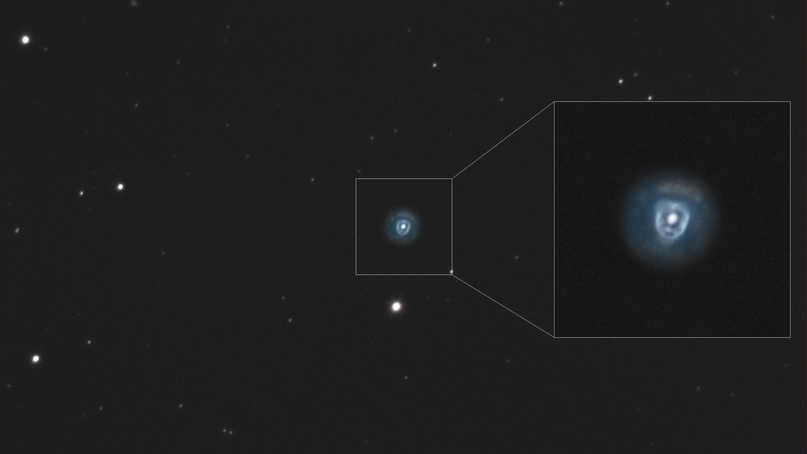
Some information regarding processing and imaging:
Regular field:
Stacking of frames: Sum of 200 frames out of 1000
Total exposure time: 400s
Frame parameters: 200 x 2" ISO/Gain: 150
Zoomed-in field:
Stacked frames: Sum of 500 frames out of 2500
Total exposure time: 500s
Frame settings: 500 x 1" ISO/Gain: 150
The square-framed photo represents an unstretched, cropped image captured with the use of a Barlow lens.
The main photo is an unstretched, uncropped image taken without the use of any lenses.
The framed photo reveals intricate details of the nebula.
Our team of experts is ready to provide you with recommendations on the top models of Barlow lenses for telescopes.
We can also give you the most up-to-date information about availability, payment options, and delivery conditions for customers from Ivanovo.
Quick and reliable delivery
Convenient payment methods
100% satisfaction guarantee
Barlow lenses for telescopes: how they work
In the early 9th century, mathematician Peter Barlow invented a new design for telescopes that revolutionized astronomical technology.
This design involves placing a scattering lens (either concave or a system of lenses) in front of the telescope eyepiece.
Since then, this lens has been named after its inventor and is commonly referred to as a Barlow lens.
These types of lenses are not only utilized in telescopes, but they are also commonly found in other optical equipment. However, for astronomical instruments, this particular device remains highly sought after.
The primary purpose of incorporating Barlow lenses in astronomical technology is to significantly increase the overall magnification of a telescope while minimizing aberrations. A Barlow lens with a magnification factor of two will double the total magnification of the instrument.
The operating principle behind this solution is quite simple. By adjusting the magnification, the lens decreases the convergence of the light cone that enters the eyepiece, effectively increasing the focal length of the lens.





